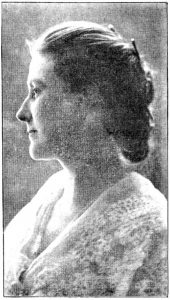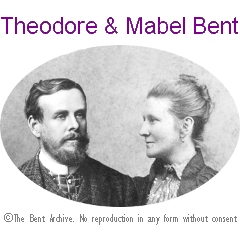
Mabel Bent died at her home at 13 Great Cumberland Place, London (near Marble Arch) on 3 July 1929; it is the 90th anniversary of her death. Her doctor recorded ‘myocardial failure’ and ‘rheumatoid arthritis (chronic)’ on her death certificate. Theodore Bent had died in the same house on 5 May 1897. A few years before her death, Mabel, or her relatives (her niece Hilda was with her when she died), had wrapped the few souvenirs that remained of her travels with her husband Theodore, and presented them without fuss to the British Museum. There is a family myth that she was confused in her final months and died in the street and was destined for a pauper’s grave before being claimed – but there is no evidence for this. In her will she bequeathed ‘all the contents whatsoever of 13 Great Cumberland Place to my sister Ethel Bagenal’. Ethel survived her by a year and a half; by then all Mabel’s and Theodore’s memories of travel had been dispersed (some wonderful and unique things are lost or out of sight) and the explorers themselves were somewhere else.
‘Nature’ of 13 July 1929, page 65, marked her in passing: “The death of Mrs. Theodore Bent on July 3, at the age of eighty-three, has removed a striking personality for many years familiar in literary and scientific circles in London. She was the widow of Theodore Bent, whom she married in 1877. Of Irish extraction, she preserved to the end of her life some of the characteristics of her nationality, notably readiness in conversation and a sharpness in repartee… Mrs. Bent accompanied her husband and gave him valuable assistance in his many journeys of archæological exploration… Journeys to Asia Minor in 1888 and to the Bahrein Islands in the Persian Gulf in 1889 were followed by their best-known expedition in 1891, when they visited South Africa to study the ancient ruins at Zimbabwe in Mashonaland, then examined and measured systematically for the first time. The results of the expedition were embodied in ‘The Ruined Cities of Mashonaland’ which appeared in 1892. Bent held the view that the builders of Zimbabwe were a northern race from Arabia, and for the rest of his life – he died in 1897 – their expeditions had as their object to discover traces of such a race… Mrs. Bent was an experienced photographer, as well as an accurate observer, as was shown by the book ‘Southern Arabia’, published in 1900, which was written mainly by her with the aid of her husband’s journals.”
The obituary might well have ended “Ní bheidh a leithéid ann arís – Her like will not be seen again”, the Irish epitaph later selected for Mabel’s great-niece Evelyn Booth, 1897-1988, born in the year Theodore died (Scannell, M.J.P. and Nelson, E.C. (1990). ‘Obituary: Evelyn Mary Booth 18971988’, The Irish Naturalists’ Journal, Vol. 23 (No. 5/6, Jan-Apr), 169-73.)
She is buried with Theodore in St Mary’s, Theydon Bois, outside London, go visit her.
 Leave a comment or contact us about this article
Leave a comment or contact us about this article